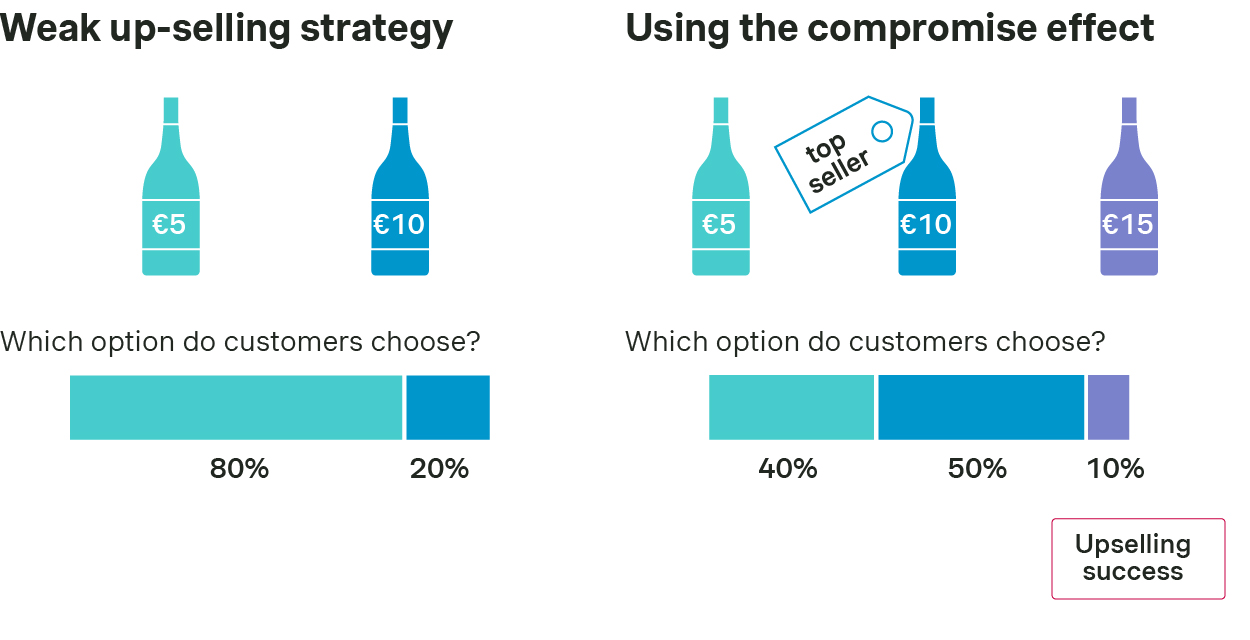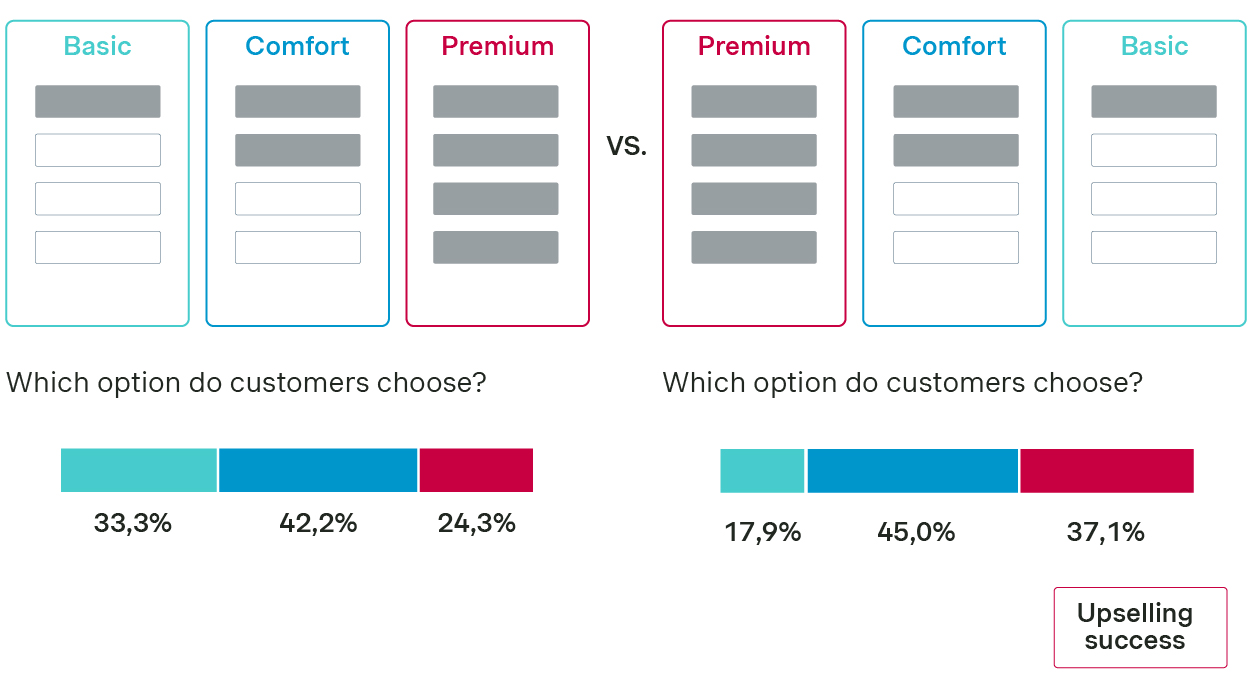Turn purchases into relationships with effective cross- and upselling strategies.
Relevant products, satisfied customers. Make every interaction an opportunity.
Discover how to seamlessly integrate relevant products into your customer journey, making shopping experiences more convenient, fulfilling, and profitable.
Why are cross- and upselling important?
Upselling and cross-selling are strategies for increasing sales and enhancing your bottom line.
Cross-selling helps increase the average transaction value by encouraging customers to purchase additional items. This boosts overall sales and profitability without the need to acquire new customers. Effective cross-selling can also help move inventory faster, reducing storage costs and minimizing the risk of overstocking.
Upselling often focuses on higher-margin products, which can significantly improve the profitability of each sale. It enhances the experience by ensuring customers receive a product that better meets their needs and expectations.
In subscription-based models, upselling can lead to increased recurring revenue by offering enhanced versions of the service. This way, you position your company as a trusted advisor while customers develop loyalty to your brand.
Cross-selling works well at various points in the customer journey. It is particularly effective during the purchase process when the customer is considering related items. It can also be effective post-purchase, where follow-up communications suggest complementary products to existing customers.
Cross-selling is especially suited to segments with diverse needs as well as for products that naturally pair together. This way, the additional purchase is a logical and beneficial decision, improving customer satisfaction.
Upselling is most impactful during the consideration phase of the customer journey. Here, customers are weighing their options and can be swayed by the benefits of a higher-tier product. This strategy is effective for high-income segments and products with clearly defined tiers or versions.
At Simon-Kucher, we can help you maximize your revenue potential by selling products more effectively. Contact us today to enhance your sales techniques and drive profitability through strategic cross- and upselling initiatives.
Customer data serves as the foundation for successful upselling and cross-selling strategies. It provides insights into preferences, purchase history, and behavior patterns. By analyzing this data, you can identify opportunities to make personalized recommendations that are more likely to resonate with individual customers.
Customer segmentation
Segmenting customers based on demographics, past purchases, or browsing behavior allows for personalized upselling offers. For example, you could send targeted upsell emails featuring accessories that complement recent purchases.
Purchase history analysis
By examining a customer's past purchases, you can identify patterns and preferences that inform targeted recommendations, enhancing both customer satisfaction and business profitability. Using data analytics, you can then generate personalized suggestions that align with the customer’s buying habits. This increases the likelihood of acceptance and improves the shopping experience.
Behavioral data
Tracking customer behavior on your website or app provides valuable insights. If a customer repeatedly visits a particular product page or spends time exploring specific features, this indicates interest. You can use this data to recommend related products or upgrades that align with the customer's demonstrated interests.
Predictive analytics
Using predictive analytics, you can forecast what customers might need next based on historical data and trends. This proactive approach enables timely cross-selling and upselling offers. For instance, you might offer a discounted upgrade just before a customer's current subscription expires.
CRM integration
Integrating customer relationship management (CRM) systems with sales data allows for a holistic view of the customer journey. This integration enables sales to have informed conversations with customers, suggesting relevant cross- and upsell opportunities based on the latest interactions and historical data.
Unlock the benefits of cross-selling and upselling. Speak to a Simon-Kucher specialist to find out how to make better use of your customer data. Contact us today.
Gamification leverages game design elements in non-game contexts to boost customer engagement, motivation, loyalty, and cross-selling. It leads to higher customer retention and increased spending as customers strive for statuses and rewards.
Gamification could mean customers earning points for purchases and buying recommended complementary products. It could be progressing through levels and earning badges like "Gold Member" status to unlock exclusive offers. Challenges such as buying specific product combinations and leaderboards can also encourage competition and cross-category purchases.
Understanding how people think and make decisions is crucial for effective gamification strategies. Most companies tend to communicate using heavy text, detailed information, and logical reasoning. However, this rational and slow thinking process requires significant effort and is not readily accessible to everyone.
At Simon-Kucher, we specialize in gamification techniques rooted in insights from behavioral economics. Looking to design cross-selling strategies that tap into your customers' more intuitive thinking? Contact us.
Another example is product bundling. Bundling combines multiple products or services into a single package, often offered at a discounted price. The perceived savings play a crucial role in customer decision-making.
Let's imagine a scenario where a customer is choosing from three bottles of wine in a supermarket.
- Lowest priced option: A budget-friendly bottle of wine.
- Middle option: A moderately priced bottle with decent quality.
- Highest priced option: An expensive, premium bottle of wine.
Here's how the compromise effect plays out:

Initially, customers may anchor their decision-making process on the lowest priced option. This sets a reference point in their minds, influencing how they perceive the value of the other options.
When you introduce a higher-priced alternative, customers gravitate toward the middle option. They seek a balance between price and quality, often choosing what seems like a reasonable compromise. The compromise effect demonstrates how subtle changes in the choice set can significantly influence consumer behavior.
Now imagine a scenario where a company offers three subscription packages for a streaming service. Initially, these packages are presented in the following order:
- Basic package: Offers standard features at the lowest price point.
- Comfort package: Provides additional features and content at a moderate price.
- Premium package: Includes exclusive content, higher quality streaming, and additional perks at the highest price.

By presenting the Premium package first, customers anchor their comparison on this top-tier option. This sets a high reference point in terms of features and benefits. The Premium package establishes a standard of what the best offering looks like. Customers perceive it as the benchmark for quality and value within the available options.
By strategically altering the order of packages, you can influence customer choices and preferences significantly. Contact Simon-Kucher today to discover how compelling product presentation can boost your upselling initiatives and drive revenue.
Successful up- and cross-selling involves a customer-centric approach to build trust and long-term relationships. Shift the focus from merely making sales to genuinely helping customers find solutions that meet their needs.
Sales must have a comprehensive understanding of your entire product and service portfolio. This includes the features, benefits, and differentiators of each offering, and how they translate into value for the customer.
You should also reflect the importance of cross- and upselling in your sales incentive programs. Offer bonuses, commissions, or other rewards for meeting specific sales targets related to these activities. Ensure that the incentive structure aligns with your overall business goals and encourages behaviors that enhance the customer experience.
It's also crucial to equip your sales team with the right tools and technology to support their cross-selling and upselling efforts. Utilize CRM software, sales enablement platforms, and data analytics to streamline the sales process and provide real-time insights. AI-powered recommendation engines can suggest relevant products based on customer data, making it easier to identify opportunities.
Contact us today to prepare your sales team for successful up- and cross-selling initiatives.
How we've helped
Enhance up- and cross-selling with Simon-Kucher
Get in touch
With almost 40 years of experience, we help you prioritize and implement the right commercial growth strategies to outperform market trends. We take a 360 degree approach to understand the behavior and needs of the market, combining our expertise and agile mindset with our client’s knowledge to unlock your sustainable, profitable growth potential and do so at pace.







